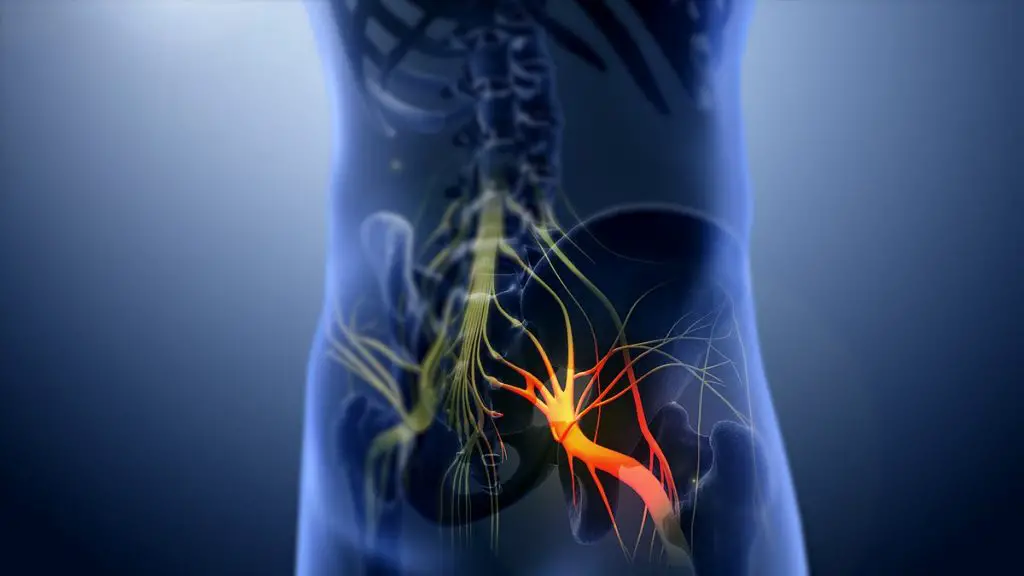La nerve tumor sciatica (Schwannoma) is a rare type of tumor that forms in the nervous system. It develops from cells called Schwann cells. This tumor is often benign, which means that they are not cancerous. But, in rare cases, they can become cancerous.
In this article, you will see everything there is to know about the tumor of the sciatic nerve including symptoms and treatments.
Definition and anatomy
Le sciatic nerve is the longest and largest nerve in the body. The roots which constitute it are born in the lower back and go down to the back of each leg.
The sciatic nerve arises from the junction of five spinal nerves at the level of the vertebrae L4, L5, S1, S2 and S3.
In both lower limbs, the sciatic nerve follows a similar route.
It passes first through the pelvis, between the superior twin muscle (below) and the pyramidal muscle (above). Then, it crosses the inside of the buttock between the gluteus maximus muscle (located behind) and the upper and lower twin muscles, the quadratus femoris and the internal obturator muscle (located in front).
Arrived in the thigh, the sciatic nerve descends vertically in the middle of the femur to reach the back of the knee. At this point it splits into two branches.
- The tibial nerve: it innervates the back of the leg to the ankle and the sole of the foot.
- The common fibular nerve: it separates into two branches at the head of the fibula (fibula), one extends towards the outer part of the leg and the other towards the anterior part.
To learn more about the anatomy of the lumbar spine and sciatic nerve, click here.
The sciatic nerve has both a sensory and a motor role. That is why, in the event of damage or compression on either side of the nerve along its course, the patient may experience pain and weakness in certain parts of the lower limb.
There are several pathologies related to the sciatic nerve.
- Sciatica: pain or discomfort that occurs when the sciatic nerve is compressed or pinched.
- Lumbosciatica: pain that affects the musculoskeletal system from the back to the foot. It comes from inflammation of the sciatic nerve.
- The tumor of the sciatic nerve (the rarest): it manifests itself by various sciatic neuralgia.
Focus on the sciatic nerve tumor
La sciatic nerve tumor, also called Schwannoma, is a tumor that develops from Schwann cells in the peripheral nervous system or in the nerve roots.
We speak of Schwannoma when the tumor is benign.
Schwannomas are generally slow growing. According to statistics, those at risk are usually men and women between the ages of 30 and 60.
It can affect any nerve region of the body, but very commonly affects peripheral nerves. It is detected in the cochleovestibular nerve, at the level of the brachial plexus, in the nerve trunks of the limbs, in the retroperitoneum (behind the peritoneal cavity), in the posterior mediastinum, in the sacral plexus (the lower group of nerves). back).
Schwannoma can be diagnosed through imaging tests.
- An MRI: the preferred imaging test for locating and diagnosing schwannomas.
- CT (computed tomography: uses x-rays and computers to produce images of structures inside your body)
- An ultrasound.
A specialist may also perform a biopsy to check if the tumor is indeed a schwannoma. To learn more about Schwannoma and its different types, see this page.
What are the symptoms of a schwannoma?
Schwannomas grow slowly and can exist for years without any symptoms.
However, when it becomes symptomatic, the sciatic nerve schwannoma generates signs like:
- pain radiating along the path of the nerve;
- a visible bump that may be tender when you put pressure on it;
- numbness;
- muscle weakness.
The symptoms of sciatic nerve schwannoma can imitate a herniated disc with lower back pain, with radiating pain down the leg.
Also, because schwannomas can form in many different areas of your body, symptoms vary widely. Some people may have more symptoms than others, and they can range from mild to severe.
Is that bad ?
Apart from the motor gene and the pain it causes, the sciatic nerve schwannoma is primarily a non-cancerous (benign) Schwann cell tumour.
It only turns into malignant schwannoma (cancer) only in rare cases. The risk is 4%, and this only in the presence of developing Von Recklinghausen syndrome.
What to do then?
The standard treatment for benign nerve tumors is surgery. The neurosurgeon uses an operation technique called radiosurgery. It involves removing the section of the nerve on which the tumor is growing. In this way, the nerve functions of the affected nerve can be preserved. Compression of other nearby organs is also avoided.
Radiosurgery uses many precisely focused beams of radiation to destroy tumors. A healthcare specialist may recommend radiosurgery if the tumor is near vital blood vessels or nerves to prevent possible complications.
As for malignant tumours, the only treatment is based on the complete removal of the diseased nerve. And, in addition to the treatment, there will be chemotherapy and radiotherapy.






